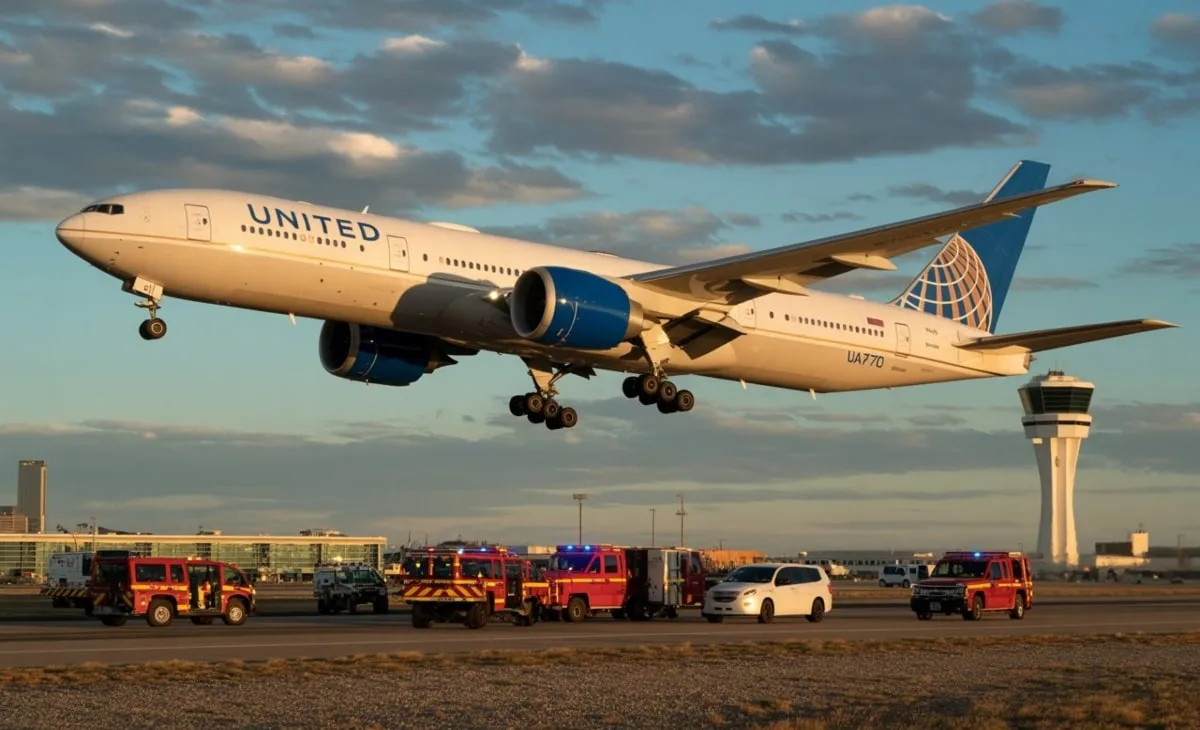For the 167 passengers aboard United Airlines Flight UA770 emergency diversion on July 12, 2025, it began like any other cross-country journey. The Boeing 737-900 departed from Newark Liberty International Airport en route to Los Angeles, promising a routine flight across the United States. However, a disruption occurred mid-air. A cockpit alert notified the pilots of a potential hydraulic system issue—a signal that demanded immediate attention.
Rather than risking a full journey with a suspected fault in one of the aircraft’s core control systems, the pilots decided to divert the flight. The chosen location for the emergency landing was Denver International Airport, a major hub with the capacity and preparedness to handle such situations. Thanks to the crew’s swift action and calm execution, the landing was smooth, controlled, and—most importantly—safe. Every passenger disembarked unharmed.
What followed was a masterclass in aviation response, demonstrating how training, protocols, and communication come together to maintain safety, even when things don’t go as planned.
How It Unfolded: A Sudden Mid-Air Alert
Hydraulic systems in aircraft control key operations—landing gear, brakes, steering, and flight control surfaces. On Flight UA770, the warning indicators pointed to a possible failure or pressure drop within one of these systems. Although commercial aircraft are designed with redundancy (multiple hydraulic systems that back each other up), a single alert is enough to change course—literally.
Pilots are trained extensively to react quickly but without panic. As soon as the warning appeared, they followed established emergency checklists, analyzed the data, and coordinated with United’s operations and ground control teams. Denver’s proximity and its world-class facilities made it the optimal location for an unscheduled landing.
The Diversion to Denver: Precision Under Pressure
Within minutes, Denver International Airport was notified and began preparing for the aircraft’s arrival. Fire crews, emergency medical teams, and ground staff were stationed at the runway, ready for any contingency. Inside the plane, the captain informed passengers of a “precautionary landing,” choosing wording and tone carefully to avoid unnecessary fear.
The descent into Denver was steady. Onboard, flight attendants moved through the cabin to ensure passengers were secured and calm. The aircraft touched down without incident, taxiing to a remote stand where passengers deplaned safely.
While it was an emergency diversion, it felt—according to several passengers—surprisingly ordinary. The professionalism of the crew made all the difference.
Passenger Experience: Confidence in Crisis
For travelers mid-flight, an emergency diversion can spark a cascade of emotions—concern, confusion, and sometimes outright fear. But on UA770, passengers later reported a sense of confidence that prevailed over chaos.
One traveler described the announcement as “matter-of-fact,” noting how the captain’s calm voice reassured everyone. “You could tell they had it under control,” another said. “The crew didn’t look worried, and that helped keep us from worrying too.”
Once safely in Denver, passengers received updates, support, and rebooking assistance from United Airlines. Despite the inconvenience, the staff’s transparency and empathy mitigated the impact.
The Aircraft: Built for Backup and Safety
The Boeing 737-900 used for Flight UA770 is part of a modern, reliable fleet. Like all commercial aircraft, it is equipped with multiple redundant systems. In the case of a hydraulic warning, the plane can typically continue flying safely—but it becomes a matter of risk management.
By diverting early, the crew ensured they weren’t gambling on the unknown. Denver’s long runways and full emergency services meant that even if the issue worsened, they’d be landing in a facility fully equipped to respond.
Maintenance crews immediately began inspecting the aircraft upon landing, focusing on hydraulic fluid levels, system pressures, and diagnostic data recorded during the flight.
United Airlines’ Response: Transparent and Timely
Following the diversion, United Airlines released a statement confirming the aircraft’s early landing was due to “a system alert in the cockpit that prompted precautionary measures.” They emphasized that safety was the top priority and credited the flight crew for managing the situation effectively.
Passengers were offered accommodations, meal vouchers, and rescheduled flights. For those needing to reach Los Angeles urgently, alternative options were arranged within hours.
United’s social media team also worked in tandem with ground operations, ensuring the public and media received accurate updates promptly—an approach that helped avoid confusion or sensationalism.
The involvement of the FAA and Aviation Safety Bodies was crucial in the response process.
As per standard protocol, the Federal Aviation Administration (FAA) was immediately notified. Flight data recorders and cockpit voice recordings were secured, and a routine investigation was launched to determine the cause of the alert.
Although there was no crash or damage, the FAA treats such diversions seriously, as part of its broader commitment to continuous safety improvement. The National Transportation Safety Board (NTSB) was briefed but did not launch a full investigation, deeming the incident well-handled and non-critical.
Still, the collected data will be analyzed for insights—ensuring training materials, maintenance protocols, and system designs continue evolving.
Denver International Airport’s Role: Fast, Coordinated, and reliable
Denver International Airport isn’t just one of the busiest airports in the country—it’s also among the best-prepared for aviation contingencies. Its response to UA770’s diversion was fast and flawlessly executed.
From the moment the alert came through, emergency teams were activated. The airport’s control tower, operations center, and airline liaisons worked in lockstep. By the time Flight UA770 landed, the runway was cleared, emergency crews were in place, and passenger transport was ready.
Their actions allowed not only a smooth landing but also a swift transition back to safety and normalcy for all involved.
Lessons from UA770: Aviation Safety in Action
For the public, incidents like UA770’s emergency diversion are powerful reminders of how prepared modern aviation really is. The entire process—from cockpit alerts to safe landings—is governed by systems designed to anticipate, not just react.
Emergency landings might sound alarming, but they’re often the result of exactly what we hope to see: early detection, superior judgment, and flawless execution. It’s not failure—it’s preparedness doing its job.
In fact, what made UA770 noteworthy was how unremarkable the diversion ended up being. There were no injuries, no panic, and the crew handled the unexpected situation with quiet confidence.
Conclusion: Prepared, Professional, and Proven Safe
The United Airlines Flight UA770 emergency diversion serves as a modern case study in aviation excellence. From a mid-air warning to a textbook diversion, every layer of safety worked as designed. Pilots assessed the risk, crews communicated effectively, and ground teams delivered support without delay.
It’s a strong message to passengers and industry watchers alike: aviation safety isn’t just about avoiding problems—it’s about being ready when they appear. UA770’s story shows that even when plans change 30,000 feet in the air, well-trained professionals and reliable protocols ensure the safest possible outcome.
FAQs About United Airlines Flight UA770 Emergency Diversion
What happened on United Airlines Flight UA770?
A cockpit warning indicated a possible hydraulic issue, prompting the pilots to divert to Denver for safety.
Was anyone injured during the emergency landing?
No. All passengers and crew landed safely without injury.
Why was Denver International Airport chosen for the diversion?
Denver was along the flight path, fully equipped for emergencies, and allowed for a quick, safe landing.
Could you please clarify if the plane experienced a significant mechanical failure?
Initial reports suggest it was a precautionary alert. A full inspection was launched post-landing to confirm.
How did United Airlines respond to the situation?
United offered clear communication, rebooking assistance, and accommodations and launched a thorough safety inspection.
Are emergency diversions common in aviation?
They are uncommon but not rare. They are safety-first decisions made when even minor warnings arise.


